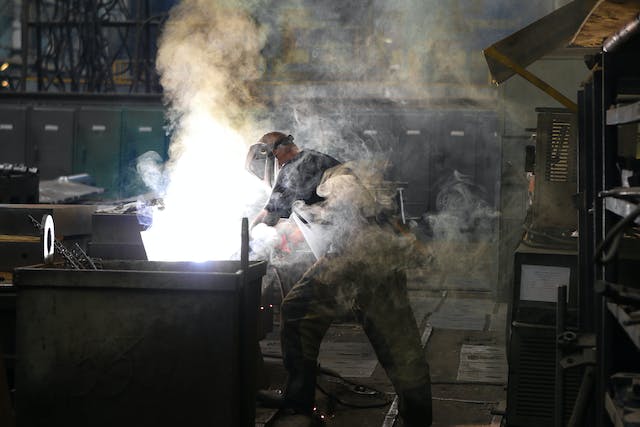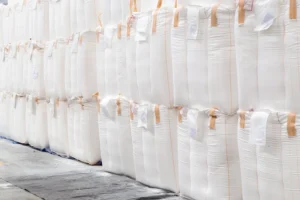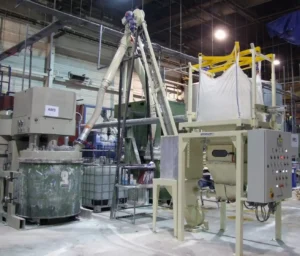The most common problem with unloading bulk bags is dusting. So, let’s dive into solving bulk bag unloader dusting problems with Spiroflow conveyor solutions and other equipment.
Frequently, bulk bag unloader operations are a dusty mess. At best, this results in a housekeeping problem. Product loss and quality control issues can arise, and the worst case is a safety issue when dealing with ingredients that pose a health or explosion risk.
Financial Impact of Bulk Bag Dusting
In today’s industrial landscape, the efficient management of bulk materials is crucial for maintaining productivity and cost-effectiveness. With the advent of advanced conveyor technologies, including conveyor belts and similar conveyor belt solutions, and the innovative flexible screw conveyor, the way materials are handled has been revolutionized. However, even with the most sophisticated belt conveyor system or other industrial conveyor systems, challenges such as bulk bag dusting can have a significant financial impact. Understanding these challenges is vital for businesses looking to optimize their operations.
Financial Impact of Ingredient Yield
Every particle of ingredient that escapes the bulk bag unloading process and ends up on the floor reduces ingredient yield and increases cost. Thinking of dusting at the particle level implies little financial impact. The following example identifies the potential magnitude of the issue.
Consider a bulk bag unloader that discharges one 2,000 lb bulk bag per hour. Discharging takes place eight hours per day, five days per week, and 48 weeks per year (allowing for scheduled maintenance and unscheduled production downtime). Let’s also say the product has a bulk density of 40 lb/ft3 and costs 50 cents per lb.
If only one pound of ingredient ends up on the floor every time a bulk bag is discharged, the annual cost of the reduced yield is $960.00 – almost the cost of a one-ton bulk bag of ingredient. To put this in perspective, one pound of our example ingredient would fit in a cube with 3 1/2″ sides – not much of a spill size-wise, but it can add up quickly. If you increase the number of bags unloaded per year, the price of the ingredient, or the amount of product lost, the financial impact increases significantly.
Labor Costs of Dusting
Unloading bulk bags can be the worst job in the plant if it is a dusty, messy process. Something not so obvious is operator productivity. Clean-up time obviously increases as dusting increases. Consider the cost of employing an operator at $17 per hour, spending 15 minutes per day (5 days per week, 48 weeks per year) cleaning the bulk bag unloading area. Over the course of a year, the company has lost 60 hours ($1,020) of operator productivity.
Safety and Health Concerns
The cost of safety problems can be immense. If you discharge ingredients that are health hazards or whose dust can, when concentrated and exposed to a suitable source of ignition, explode, great care must be taken to minimize dusting to the greatest extent possible.

Solving Bulk Bag Unloader Dusting Problems With 3 Components
Addressing dust containment in bulk material handling requires a multifaceted approach, combining the right design elements with effective operator practices. The key lies in three fundamental areas:
- Some ingredients can sift through the bulk bag fabric. This can occur when the bag is being handled or when it is being discharged. Coating the inside of the bag or bulk bag liners solves this problem.
- Dusting can occur at the onset of product flow, during discharge, and at the end of the discharge cycle when the bag is being removed from the bulk bag unloader. Your equipment must be designed with specific features to contain dust according to when the problem arises in the discharge cycle.
- It is common to see operators using bulk bag unloading equipment in a manner that does not follow the manufacturer’s instructions. This can be a leading contributor to excessive dusting. It is also critical to follow the manufacturer’s procedures on how to load the bulk bag into the unloading equipment, initiate product flow, and remove the empty bag. Operator training starts with well-thought-out Standard Operating Procedures, and its benefit is sustained by constant reinforcement and supervision.
Discharging Hazardous Ingredients
Containing dust that is either a health hazard or explosive is obviously critical. The consequences of not doing so are potentially devastating.
Special Liners
Bulk bags may be required that include specialized liners made from material that will eliminate gas transfer into the atmosphere. Long outlet spouts on both the bag and liner may be required to properly mate with specialized bulk bag discharging equipment.
Equipment Design
Bulk bag unloaders designed to provide total containment almost always include a means of sealing the bulk bag and liner outlet spout to a metal downspout that is connected to downstream equipment. This eliminates dust emissions during the onset of ingredient flow and throughout the emptying of the bag.
However, when the bulk bag is empty and must be removed, dust particles can become airborne when the outlet spout is unsealed and the empty bag is removed from the bulk bag unloader. To prevent this secondary emission of dust particles, the bulk bag outlet sealing or clamping mechanism can be enclosed in a chamber that is maintained under negative pressure. This prevents dust from escaping into the plant environment when the bag outlet is re-tied and the bulk bag is prepped for removal and disposal. Some designs include a way to completely evacuate the bulk bag – collapsing it in the process – while it is still attached to the bulk bag unloader.
Enhance Your Bulk Material Handling with Spiroflow Conveyor Solutions
Effective dust containment in bulk material handling is achievable through a combination of well-designed bulk bags, specially engineered bulk bag unloaders, and thorough operator training. These strategies are not only essential for maintaining a clean and safe working environment but also for enhancing the efficiency and cost-effectiveness of your operations.
As one of the leading conveyor systems manufacturers, Spiroflow offers a range of conveyor belt systems designed to meet the unique needs of your business. Our expertise as conveyor manufacturers allows us to provide solutions that address the specific challenges of dust containment in bulk bagging. If you’re looking to improve your conveyor belt system or seeking innovative solutions for bulk material handling, contact Spiroflow today.





